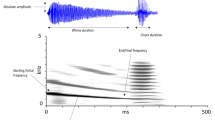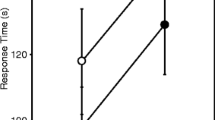Summary
-
1.
Most crickets first demonstrated positive phonotaxis to 65 dB CSs having a 53–62 ms SP by day 3 following the imaginal molt (Fig. 3B). The onset of copulatory readiness occurred on average at 3.2 days.
-
2.
The attractive range of SPs for most females became progressively broader as they aged (Fig. 4). Three to 4-day-old females were attracted to a smaller number of CS SPs than were 20–21 day old females (Fig. 4).
-
3.
Older, less selective females did not typically respond to the same range of CS SPs (Fig. 6). However, they were more likely to respond to some SPs (especially 50 ms) than to others (Fig. 7).
-
4.
The phonotactic threshold decreased from 95 dB or greater on day 0 to a mean of 55 dB by day 3, during a period of increasing JHIII biosynthesis, and thereafter remained at that level (Fig. 8).
-
5.
During a period of maximal JHIII production, 3–5 day-old females usually responded to 4 of the 7 SPs presented (Fig. 8). Females older than 12 days were unselective for CS SP, and JHIII synthesis remained at a level below the peak production on day 4 (Fig. 8).
-
6.
Older females, that were unselective for CS SP, became as selective as 3 to 5-day-old females within 4 days of topical application of JHIII (Figs. 9–11).
Similar content being viewed by others
Abbreviations
- CS :
-
calling song
- SP :
-
syllable period
- POD :
-
polar orientation diagram
- JHIII :
-
juvenile hormone III
- CA :
-
corpora allata
References
Atkins S, Atkins G, StoutJF (1989a) Influence of syllable period on song-encoding properties of an ascending auditory interneuron in the cricket Acheta domestica. J Comp Physiol A 165:827–836
Atkins G, Atkins S, Stout J (1989b) Behavioral changes in “oneeared” and “two-eared” crickets (Acheta domestica) after photoinactivation of identified prothoracic auditory interneurons. In: Erber J, Menzel R, Pflüger H, Todt D (eds), Neural mechanisms of behavior Georg Thieme, Stuttgart, New York, p. 77
Atkins G, Henley J, Stout J (1990) A neural correlate for control of syllable period selective phonotaxis in the cricket Acheta domestica by juvenile hormone III. Neurosci Abstr 16:758
Atkins nG, Henley J, Handysides R, Stout J (1991) Evaluation of the behavioral roles of ascending auditory interneurons in calling song phonotaxis by the female cricket (Acheta domestica). J Comp Physiol (submitted)
Dahmen HJ (1980) A simple apparatus to investigate the orientation of walking insects. Experientia 36:685–686
Doherty JA (1985) Trade-off phenomena in calling song recognition and phonotaxis in the cricket, Gryllus bimaculatus (Orthoptera, Gryllidae). J Comp Physiol A 156:787–801
Doherty JA, Pires A (1987) A new microcomputer-based method for measuring walking phonotaxis in field crickets (Gryllidae). J Exp Biol 130:425–432
Espig W, Hoffmann KH (1985) Juvenile hormone and reproduction in the cricket. II. Effect of rearing temperature on corpus allatum activity (in vitro) in adult females. Experientia 41:758–759
Henley J, Greenwood G, Stout J, Atkins G (1991) Age-correlated charges and Juvenile Hormone III regulation of the syllable period specific responses of the L3 auditory interneurons in the cricket, Acheta domesticus. J Comp Physiol (submitted)
Hoy RR, Hahn J, Paul RC (1977) Hybrid cricket auditory behavior: Evidence for genetic coupling in animal communication. Science 195:82–84
Koch PB, Hoffmann KH (1985) Juvenile hormone and reproduction in crickets, Gryllus bimaculatus De Geer: corpus allatum activity (in vitro) in females during adult life cycle. Physiol Entomol 10:173–182
Koudele K, Stout JF, Reichert D (1987) Factors which influence female crickets' (Acheta domesticus) phonotactic and sexual responsiveness to males. Physiol Entomol 12:67–80
Loher W, Schooley DA, Baker FC (1987) Influence of the ovaries on JH titer in Teleogryllus commodus. Insect Biochem 17:1099–1102
Pratt GE, Tobe SS (1974) Juvenile hormones radiobiosynthesised by corpora allata of adult female locusts in vitro. Life Sciences 14:575–586
Pratt GB, Tobe SS, Weaver RJ, Finney JR (1975) Spontaneous synthesis and release of C16 juvenile hormone by isolated corpora allata of female locust Schistocerca gregaria and female cockroach Periplaneta americana. Gen Comp Endocrinol 26:478–484
Renucci M, Strambi C (1983) Juvenile hormone levels, vitellogenin and ovarian development in Acheta Domesticus. Experientia 39:618–620
Sakaluk SK (1982) Onset of phonotaxis and age at first mating in female house crickets, Acheta domesticus (Orthoptera: Gryllidae). New York Entomol Soc 90:136–141
Schildberger K (1984) Temporal selectivity of identified auditory neurons in the cricket brain. J Comp Physiol A 155:171–185
Shuvalov VF, Popov AV (1971) The reaction of females of the domestic cricket Acheta domesticus to sound signals and its changes in ontogenesis. J E vol Biochim Fisiol 7:612–616
Stout J, McGhee R (1988) Attractiveness of the male Acheta domesticus calling song to females. II. The relative importance of syllable period, intensity and chirp rate. J Comp Physiol A 164:277–287
Stout J, DeHaan C, McGhee R (1983) Attractiveness of the male Acheta domesticus calling song to females. I. Dependence on each of the calling song features. J Comp Physiol 153:509–521
Stout J, Atkins G, Burghardt F (1985) The characterization and possible importance for phonotaxis of “L”-shaped ascending acoustic interneurons in the cricket (Acheta domesticus). In: Kalmring K, Elsner N (eds.) Acoustic and vibrational communication in insects. P. Parey, Hamburg, pp. 89–100.
Stout J, Atkins G, Weber T, Huber F (1987) The effect of visual input on calling song attractiveness for female Acheta domesticus. Physiol Entomol 12:135–140
Stout JF, Walikonis RW, Atkins G (1989) The influence of age and JHIII levels on the sound processing characteristics of ascending auditory neurons in female crickets (Acheta domestica) In: Proceedings of the Second International Congress of Neuroethology. George Thieme, Stuttgart, p 75
Stout J, Atkins G, Zacharias D (1991) Regulation of cricket phonotaxis through hormonal control of the threshold of an identified auditory neuron. J Comp Physiol A 169:765–772
Tobe SS, Pratt GE (1974) The influence of substrate concentrations on the rate of insect juvenile hormone biosynthesis by corpora allata of the desert locust in vitro. Biochem J 144:107–113
Thorson J, Weber T, Huber F (1982) Auditory behavior of the cricket. II. Simplicity of calling-song recognition in Gryllus, and anomalous phonotaxis at abnormal carrier frequencies. J Comp Physiol 146:361–378
Weber T, Thorson J, Huber F (1981) Auditory behavior of the cricket. I. Dynamics of compensated walking and discrimination paradigms on the Kramer treadmill. J Comp Physiol 141:215–232
Wennauer R, Kassel L, Hoffmann KH (1989) The effects of juvenile hormone, 20-hydroxyecdysone, precocene II, and ovariectomy on the activity of the corpora allata (in vitro) in adult female Gryllus bimaculatus. J Insect Physiol 35:299–304
Wicker C (1987) Effects of brain, suboesophageal ganglion and corpus cardiacum factors on juvenile hormone biosynthesis in vitro in Acheta domesticus (Orthoptera). Comp Biochem Physiol 87:161–165
Author information
Authors and Affiliations
Rights and permissions
About this article
Cite this article
Walikonis, R., Schoun, D., Zacharias, D. et al. Attractiveness of the male Acheta domesticus calling song to females. J Comp Physiol A 169, 751–764 (1991). https://doi.org/10.1007/BF00194903
Accepted:
Issue Date:
DOI: https://doi.org/10.1007/BF00194903




